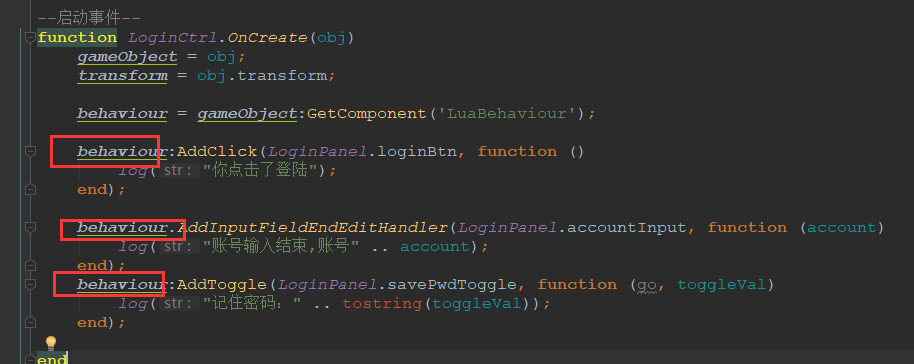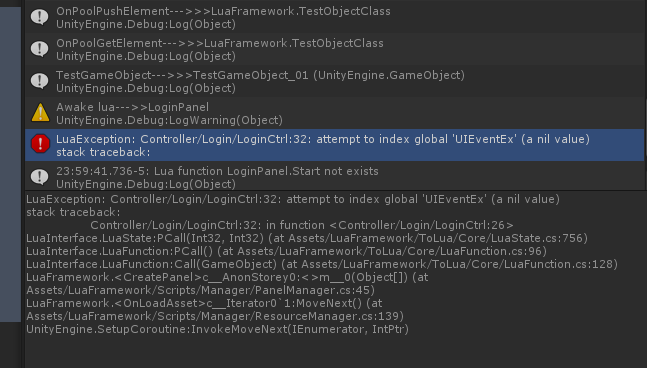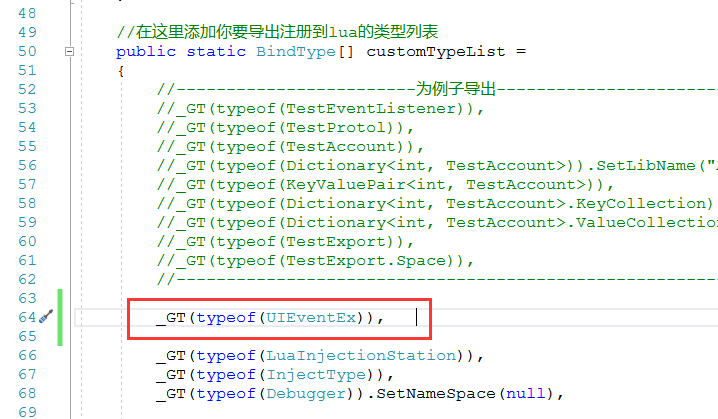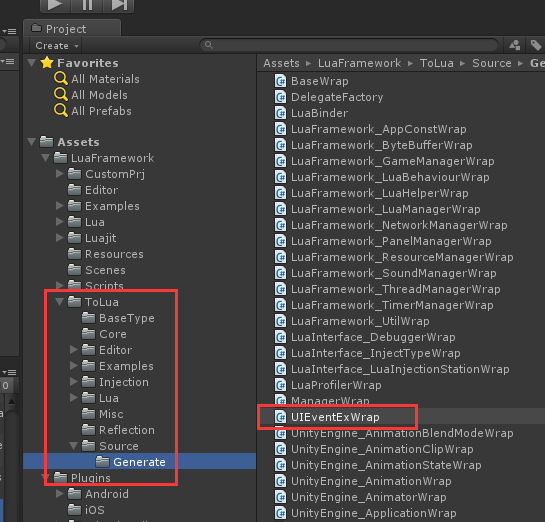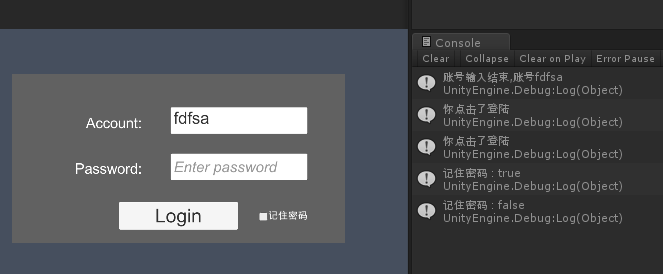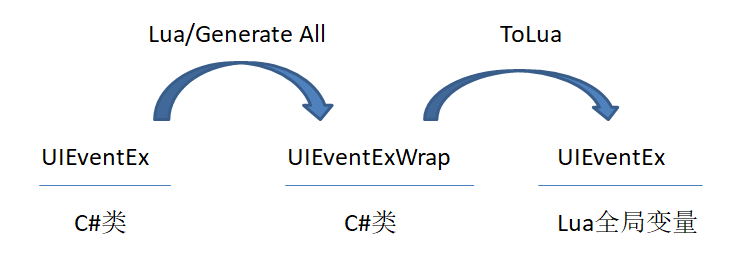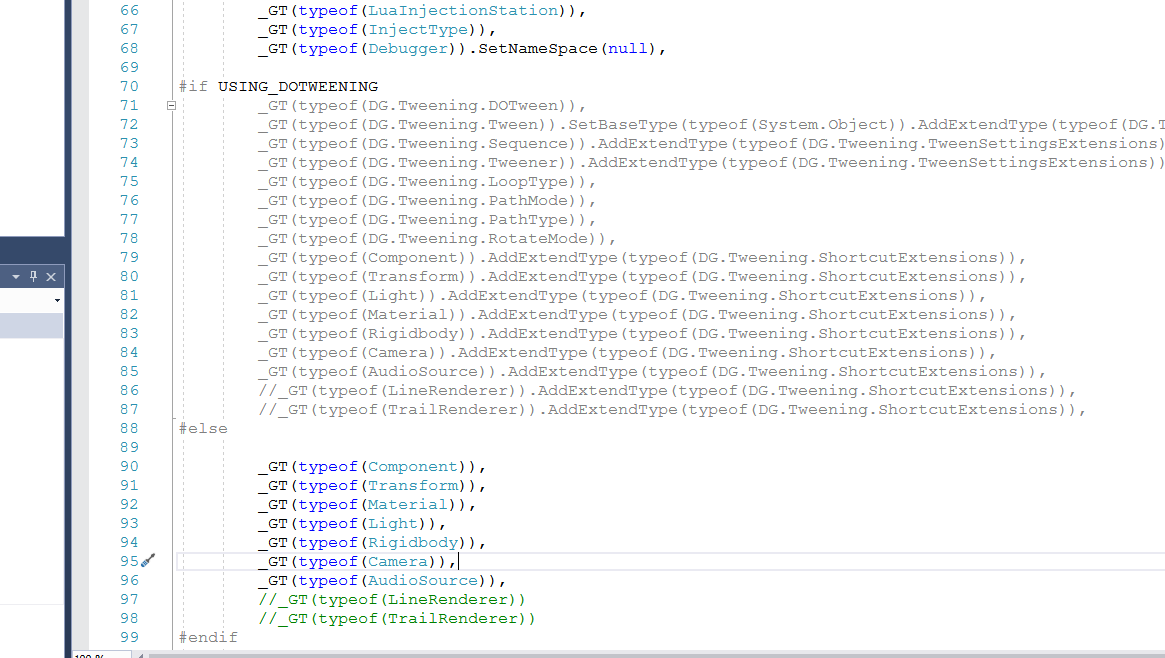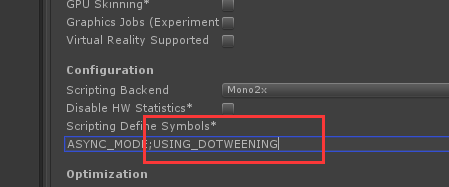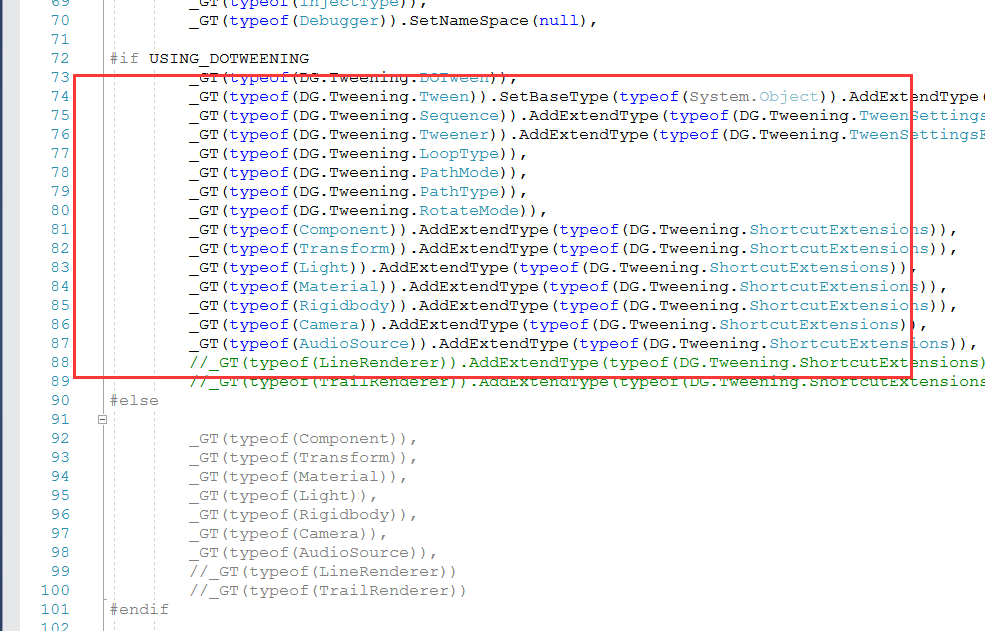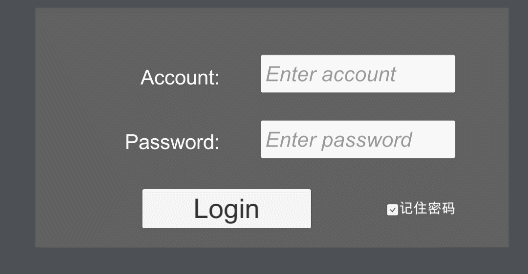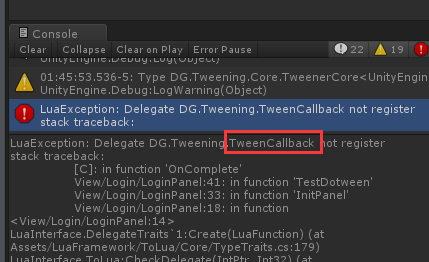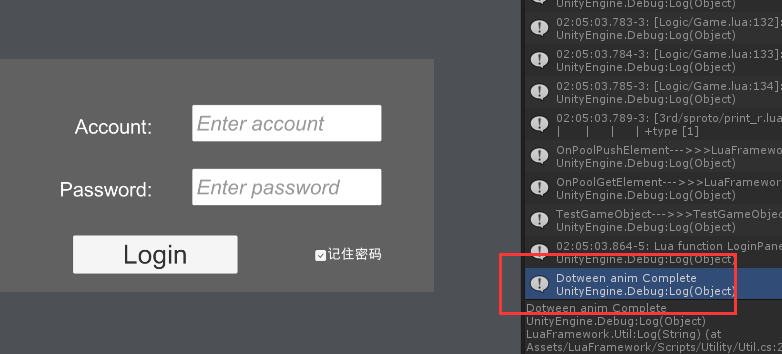在上一篇文章 Unity3D热更新之LuaFramework篇[04]--自定义UI监听方法 中,我对LuaBehaviour脚本进行了扩展,添加了两个新的UI监听方法,也提到最好能单写一个脚本处理此事。本篇文章就来继续这个工作。
从Lua中调用C#代码
1、创建UI监听脚本
打开之前的工程,在Assets/LuaFrameworks/Scripts/Common下,创建一个UIEventEx.cs脚本,将LuaBehaviour.cs中的AddButtonClick以及AddInputFieldEndEditHandler方法迁移过来,并扩展了一些其它方法,代码如下:
 UIEventEx.cs1 using LuaInterface; 2 using System.Collections; 3 using System.Collections.Generic; 4 using UnityEngine; 5 using UnityEngine.EventSystems; 6 using UnityEngine.UI; 7 8 /// <summary> 9 /// 自定义的添加UI监听的方法,可以用lua中调用以做事件绑定 10 /// </summary> 11 public class UIEventEx { 12 //添加监听 13 public static void AddButtonClick(GameObject go, LuaFunction luafunc) 14 { 15 if (go == null || luafunc == null) 16 return; 17 18 Button btn = go.GetComponent<Button>(); 19 if (btn == null) 20 return; 21 22 btn.onClick.AddListener 23 ( 24 delegate () 25 { 26 luafunc.Call(go); 27 } 28 ); 29 } 30 31 //添加监听(外带数据中转功能) 32 public static void AddButtonClick(GameObject go, LuaFunction luafunc, LuaTable luatable) 33 { 34 if (go == null || luafunc == null) 35 return; 36 37 Button btn = go.GetComponent<Button>(); 38 if (btn == null) 39 return; 40 41 btn.onClick.AddListener 42 ( 43 delegate () 44 { 45 luafunc.Call(go, luatable); 46 } 47 ); 48 } 49 50 /// <summary> 51 /// 给Toggle组件添加监听 52 /// </summary> 53 public static void AddToggle(GameObject go, LuaFunction luafunc, LuaTable luatable) 54 { 55 if (go == null || luafunc == null) return; 56 57 Toggle toggle = go.GetComponent<Toggle>(); 58 59 if (toggle == null) return; 60 61 go.GetComponent<Toggle>().onValueChanged.AddListener( 62 delegate (bool select) { 63 luafunc.Call(luatable, select); 64 } 65 ); 66 } 67 68 69 /// <summary> 70 /// 给Toggle组件添加监听 71 /// </summary> 72 public static void AddToggle(GameObject go, LuaFunction luafunc) 73 { 74 if (go == null || luafunc == null) return; 75 76 Toggle toggle = go.GetComponent<Toggle>(); 77 78 if (toggle == null) return; 79 80 go.GetComponent<Toggle>().onValueChanged.AddListener( 81 delegate (bool select) { 82 luafunc.Call(select); 83 } 84 ); 85 } 86 87 //给输入组件(InputField)添加结束编辑(OnEndEdit)监听 88 public static void AddInputFieldEndEditHandler(GameObject go, LuaFunction luafunc) 89 { 90 if (go == null || luafunc == null) return; 91 92 InputField input = go.GetComponent<InputField>(); 93 94 if (input == null) 95 { 96 Debug.LogError(go.name + "找不到InputField组件"); 97 return; 98 } 99 100 go.GetComponent<InputField>().onEndEdit.AddListener( 101 delegate (string text) { 102 luafunc.Call(text); 103 } 104 ); 105 } 106 107 /// <summary> 108 /// 添加对光标按下|抬起事件的支持 109 /// </summary> 110 /// <param name="go">目标对象</param> 111 /// <param name="luafunc">按下事件</param> 112 /// <param name="luafunc2">抬起事件</param> 113 public static void AddPointerDownUpSupport(GameObject go, LuaFunction luafunc, LuaFunction luafunc2) 114 { 115 if (go == null) return; 116 117 EventsSupport es = go.AddComponent<EventsSupport>(); 118 119 es.InitDownUpHandler((PointerEventData pointerEventData) => { 120 if (luafunc != null) 121 { 122 luafunc.Call(go, pointerEventData); 123 } 124 125 }, (PointerEventData pointerEventData) => { 126 if (luafunc2 != null) 127 { 128 luafunc2.Call(go, pointerEventData); 129 } 130 }); 131 } 132 133 /// <summary> 134 /// 给Slider组件添加onValueChanged事件 135 /// </summary> 136 /// <param name="go"></param> 137 /// <param name="luafunc"></param> 138 public static void AddSliderOnChangeEvent(GameObject go, LuaFunction luafunc) 139 { 140 if (go == null || luafunc == null) return; 141 142 Slider component = go.GetComponent<Slider>(); 143 144 if (component == null) 145 { 146 Debug.LogError(go.name + "找不到Slider组件"); 147 return; 148 } 149 150 go.GetComponent<Slider>().onValueChanged.AddListener( 151 delegate (float val) { 152 luafunc.Call(val); 153 } 154 ); 155 } 156 157 //清除监听 158 public static void ClearButtonClick(GameObject go) 159 { 160 if (go == null) 161 return; 162 163 Button btn = go.GetComponent<Button>(); 164 if (btn == null) 165 return; 166 167 btn.onClick.RemoveAllListeners(); 168 } 169 170 }
UIEventEx.cs1 using LuaInterface; 2 using System.Collections; 3 using System.Collections.Generic; 4 using UnityEngine; 5 using UnityEngine.EventSystems; 6 using UnityEngine.UI; 7 8 /// <summary> 9 /// 自定义的添加UI监听的方法,可以用lua中调用以做事件绑定 10 /// </summary> 11 public class UIEventEx { 12 //添加监听 13 public static void AddButtonClick(GameObject go, LuaFunction luafunc) 14 { 15 if (go == null || luafunc == null) 16 return; 17 18 Button btn = go.GetComponent<Button>(); 19 if (btn == null) 20 return; 21 22 btn.onClick.AddListener 23 ( 24 delegate () 25 { 26 luafunc.Call(go); 27 } 28 ); 29 } 30 31 //添加监听(外带数据中转功能) 32 public static void AddButtonClick(GameObject go, LuaFunction luafunc, LuaTable luatable) 33 { 34 if (go == null || luafunc == null) 35 return; 36 37 Button btn = go.GetComponent<Button>(); 38 if (btn == null) 39 return; 40 41 btn.onClick.AddListener 42 ( 43 delegate () 44 { 45 luafunc.Call(go, luatable); 46 } 47 ); 48 } 49 50 /// <summary> 51 /// 给Toggle组件添加监听 52 /// </summary> 53 public static void AddToggle(GameObject go, LuaFunction luafunc, LuaTable luatable) 54 { 55 if (go == null || luafunc == null) return; 56 57 Toggle toggle = go.GetComponent<Toggle>(); 58 59 if (toggle == null) return; 60 61 go.GetComponent<Toggle>().onValueChanged.AddListener( 62 delegate (bool select) { 63 luafunc.Call(luatable, select); 64 } 65 ); 66 } 67 68 69 /// <summary> 70 /// 给Toggle组件添加监听 71 /// </summary> 72 public static void AddToggle(GameObject go, LuaFunction luafunc) 73 { 74 if (go == null || luafunc == null) return; 75 76 Toggle toggle = go.GetComponent<Toggle>(); 77 78 if (toggle == null) return; 79 80 go.GetComponent<Toggle>().onValueChanged.AddListener( 81 delegate (bool select) { 82 luafunc.Call(select); 83 } 84 ); 85 } 86 87 //给输入组件(InputField)添加结束编辑(OnEndEdit)监听 88 public static void AddInputFieldEndEditHandler(GameObject go, LuaFunction luafunc) 89 { 90 if (go == null || luafunc == null) return; 91 92 InputField input = go.GetComponent<InputField>(); 93 94 if (input == null) 95 { 96 Debug.LogError(go.name + "找不到InputField组件"); 97 return; 98 } 99 100 go.GetComponent<InputField>().onEndEdit.AddListener( 101 delegate (string text) { 102 luafunc.Call(text); 103 } 104 ); 105 } 106 107 /// <summary> 108 /// 添加对光标按下|抬起事件的支持 109 /// </summary> 110 /// <param name="go">目标对象</param> 111 /// <param name="luafunc">按下事件</param> 112 /// <param name="luafunc2">抬起事件</param> 113 public static void AddPointerDownUpSupport(GameObject go, LuaFunction luafunc, LuaFunction luafunc2) 114 { 115 if (go == null) return; 116 117 EventsSupport es = go.AddComponent<EventsSupport>(); 118 119 es.InitDownUpHandler((PointerEventData pointerEventData) => { 120 if (luafunc != null) 121 { 122 luafunc.Call(go, pointerEventData); 123 } 124 125 }, (PointerEventData pointerEventData) => { 126 if (luafunc2 != null) 127 { 128 luafunc2.Call(go, pointerEventData); 129 } 130 }); 131 } 132 133 /// <summary> 134 /// 给Slider组件添加onValueChanged事件 135 /// </summary> 136 /// <param name="go"></param> 137 /// <param name="luafunc"></param> 138 public static void AddSliderOnChangeEvent(GameObject go, LuaFunction luafunc) 139 { 140 if (go == null || luafunc == null) return; 141 142 Slider component = go.GetComponent<Slider>(); 143 144 if (component == null) 145 { 146 Debug.LogError(go.name + "找不到Slider组件"); 147 return; 148 } 149 150 go.GetComponent<Slider>().onValueChanged.AddListener( 151 delegate (float val) { 152 luafunc.Call(val); 153 } 154 ); 155 } 156 157 //清除监听 158 public static void ClearButtonClick(GameObject go) 159 { 160 if (go == null) 161 return; 162 163 Button btn = go.GetComponent<Button>(); 164 if (btn == null) 165 return; 166 167 btn.onClick.RemoveAllListeners(); 168 } 169 170 }在Assets/LuaFrameworks/Scripts/Common下,创建一个EventsSupport.cs脚本,该脚本是一个实现了IPointerDownHandler, IPointerUpHandler等接口的类,用于在Lua中检测鼠标输入(鼠标点击,抬起、按下等功能),配合UIEventEx.cs中的AddPointerDownUpSupport方法使用。其代码如下:
 EventsSupport.cs1 using System; 2 using System.Collections; 3 using System.Collections.Generic; 4 using UnityEngine; 5 using UnityEngine.EventSystems; 6 7 /* 其它事件可根据需要在此类中实现 8 IPointerEnterHandler - OnPointerEnter - Called when a pointer enters the object 9 IPointerExitHandler - OnPointerExit - Called when a pointer exits the object 10 IPointerDownHandler - OnPointerDown - Called when a pointer is pressed on the object 11 IPointerUpHandler - OnPointerUp - Called when a pointer is released (called on the original the pressed object) 12 IPointerClickHandler - OnPointerClick - Called when a pointer is pressed and released on the same object 13 IInitializePotentialDragHandler - OnInitializePotentialDrag - Called when a drag target is found, can be used to initialise values 14 IBeginDragHandler - OnBeginDrag - Called on the drag object when dragging is about to begin 15 IDragHandler - OnDrag - Called on the drag object when a drag is happening 16 IEndDragHandler - OnEndDrag - Called on the drag object when a drag finishes 17 IDropHandler - OnDrop - Called on the object where a drag finishes 18 IScrollHandler - OnScroll - Called when a mouse wheel scrolls 19 IUpdateSelectedHandler - OnUpdateSelected - Called on the selected object each tick 20 ISelectHandler - OnSelect - Called when the object becomes the selected object 21 IDeselectHandler - OnDeselect - Called on the selected object becomes deselected 22 IMoveHandler - OnMove - Called when a move event occurs (left, right, up, down, ect) 23 ISubmitHandler - OnSubmit - Called when the submit button is pressed 24 ICancelHandler - OnCancel - Called when the cancel button is pressed 25 */ 26 27 /// <summary> 28 /// unity事件支持(本类用于实现Unity中的各种事件,借给Lua调用) 29 /// </summary> 30 public class EventsSupport : MonoBehaviour, IPointerDownHandler, IPointerUpHandler 31 { 32 Action<PointerEventData> onPointerDownHandler = null; 33 Action<PointerEventData> onPointerUpHandler = null; 34 35 public void InitDownUpHandler (Action<PointerEventData> downHandler, Action<PointerEventData> upHandler) 36 { 37 onPointerDownHandler = downHandler; 38 onPointerUpHandler = upHandler; 39 } 40 41 public void OnPointerDown(PointerEventData pointerEventData) 42 { 43 //Output the name of the GameObject that is being clicked 44 //Debug.Log("[" + name + "] Game Object Click in Progress"); 45 46 if (onPointerDownHandler != null) { 47 onPointerDownHandler(pointerEventData); 48 } 49 } 50 51 //Detect if clicks are no longer registering 52 public void OnPointerUp(PointerEventData pointerEventData) 53 { 54 //Debug.Log("[" + name + "] No longer being clicked"); 55 if (onPointerUpHandler != null) 56 { 57 onPointerUpHandler(pointerEventData); 58 } 59 } 60 }
EventsSupport.cs1 using System; 2 using System.Collections; 3 using System.Collections.Generic; 4 using UnityEngine; 5 using UnityEngine.EventSystems; 6 7 /* 其它事件可根据需要在此类中实现 8 IPointerEnterHandler - OnPointerEnter - Called when a pointer enters the object 9 IPointerExitHandler - OnPointerExit - Called when a pointer exits the object 10 IPointerDownHandler - OnPointerDown - Called when a pointer is pressed on the object 11 IPointerUpHandler - OnPointerUp - Called when a pointer is released (called on the original the pressed object) 12 IPointerClickHandler - OnPointerClick - Called when a pointer is pressed and released on the same object 13 IInitializePotentialDragHandler - OnInitializePotentialDrag - Called when a drag target is found, can be used to initialise values 14 IBeginDragHandler - OnBeginDrag - Called on the drag object when dragging is about to begin 15 IDragHandler - OnDrag - Called on the drag object when a drag is happening 16 IEndDragHandler - OnEndDrag - Called on the drag object when a drag finishes 17 IDropHandler - OnDrop - Called on the object where a drag finishes 18 IScrollHandler - OnScroll - Called when a mouse wheel scrolls 19 IUpdateSelectedHandler - OnUpdateSelected - Called on the selected object each tick 20 ISelectHandler - OnSelect - Called when the object becomes the selected object 21 IDeselectHandler - OnDeselect - Called on the selected object becomes deselected 22 IMoveHandler - OnMove - Called when a move event occurs (left, right, up, down, ect) 23 ISubmitHandler - OnSubmit - Called when the submit button is pressed 24 ICancelHandler - OnCancel - Called when the cancel button is pressed 25 */ 26 27 /// <summary> 28 /// unity事件支持(本类用于实现Unity中的各种事件,借给Lua调用) 29 /// </summary> 30 public class EventsSupport : MonoBehaviour, IPointerDownHandler, IPointerUpHandler 31 { 32 Action<PointerEventData> onPointerDownHandler = null; 33 Action<PointerEventData> onPointerUpHandler = null; 34 35 public void InitDownUpHandler (Action<PointerEventData> downHandler, Action<PointerEventData> upHandler) 36 { 37 onPointerDownHandler = downHandler; 38 onPointerUpHandler = upHandler; 39 } 40 41 public void OnPointerDown(PointerEventData pointerEventData) 42 { 43 //Output the name of the GameObject that is being clicked 44 //Debug.Log("[" + name + "] Game Object Click in Progress"); 45 46 if (onPointerDownHandler != null) { 47 onPointerDownHandler(pointerEventData); 48 } 49 } 50 51 //Detect if clicks are no longer registering 52 public void OnPointerUp(PointerEventData pointerEventData) 53 { 54 //Debug.Log("[" + name + "] No longer being clicked"); 55 if (onPointerUpHandler != null) 56 { 57 onPointerUpHandler(pointerEventData); 58 } 59 } 60 }EventsSupport.cs脚本需要挂在待检测输入的Game Object上。
2、使用脚本
这里还是以上一篇文章写的登陆界面为例,之前我们是通过LuaBehaviour给Button、Toggle以及InputField添加的监听函数,现在将相应的用法直接替换掉。
替换前:
替换后:
然后运行,看是否生效。
......
运行结果,报错了,提示全局变量 UIEventEx为nil(就是这个变量不存在的意思)
看来这样想当然的方法是行不通了,我们不能创建一个C#脚本,然后在Lua中直接使用它。
3、C#类导出
在上一步中,我们发现无法直接在Lua中使用创建的C#脚本。通过查阅资料了解到,对自定义的c#类,如果想在Lua中使用的话,需要做一个导出操作才行。
ToLua的官方git上也有相关的说明:
跟着说明操作:
1)找到AssetsLuaFrameworkEditor下的CustomSettings.cs脚本;
2)在CustomSettings的60 行左右照例添加一个导出语句"_GT(typeof(UIEventEx)),";
3)点击Lua/Generate All菜单,等到日志打印 Generate LuaBinder over !字样时,表明Generate操作已经完成了。
此时查看AssetsLuaFrameworkToLuaSourceGenerate,能找到一个叫UIEventExWrap的cs文件,这个就是UIEventEx的导出类。
4)重新运行Unity,已经不再报错了,点击Button、Toggle、在InputField中输入字符,功能都和之前使用LuaBehaviour时一致。
总结
如果想在Lua中使用自定义的c#类,需要4个步骤:
1)创建c#脚本;
2)在CustomSetting.cs中添加导出语句;
3)点击Lua/Generate All菜单;
4)在Lua中以全局变量的形式直接使用;
这里涉及的转化过程是这样的:
1)UIEventEx脚本通过Lua/Generate All菜单生成UIEventWrap脚本;
2)UIEventWrap脚本经过ToLua的作用,最终成为Lua中的一个全局变量UIEventEx;
在之前的文章中我们曾直接使用Lua/Generate All菜单而未做解释,那么现在你应该明白它的做用是什么了。
至于ToLua怎么把一个XxxWrap转换为Lua中的全局变量,就不是本文能讲得清的了(你可以自己做弄清楚);
怎么在Lua中使用Dotween
Dotween作为一款非常优秀的缓动动画插件,基本上快成为Unity的标配了。而如果想把所有的UI逻辑全部Lua化,那么在Lua中使用Dotween就是必须的了。
根据前边的经验,Dotween相关的类对于ToLua来说,就是自定义类,想要在Lua中使用,就必须做导出操作。
那么就有以下步骤:
1)给项目导入一个Dotween插件;
2)导出Dotween相关类;
第二步就是要整理Dotween相关的类,然后一个个写导出语句,这不是一个简单的活儿。
不过不必担心,ToLua已经帮我们做好了。
打开AssetsLuaFrameworkEditor下的CustomSettings.cs脚本,在70~100行左右,能看到Dotween相关类的导出语句,不过由于未检测到USING_DOTWEENING宏定义的原因,这一段代码并未生效。
3)使用宏定义USING_DOTWEENING
一个简单的定义宏的办法是在脚本头部加入 #define USING_DOTWEENING语句,如下图
另外一个办法是在PlayerSettings的Scripting Define Symbols*下添加相应的宏,如下图:
其中ASYNC_MOD是之前有的,两个宏之间用分号隔开,输入USING_DOTWEENING 要回车一次,让脚本重新编译。
这里使用第一种办法。
定义了宏之后,Dotween相关类的导出语句就生效了,然后要执行一次Lua/Generate All。
4)在Lua中作用Dotween
以登陆界面的登陆按钮为例,在LoginPanel.lua脚本中添加如下的Dotween使用方法。
然后运行,能看到动画已经生效了(移动及循环都没问题),不过最后的回调没执行。
看日志有一个报错,说的是TweenCallback未注册。这个就是OnComplete回调未执行的原因。
TweenCallback是一个委托类型,根据此前了知识,委托类型也需要在CustomSetting中指定位置注册。
打开CustomSettings脚本,在40~50行左右的位置,添加TweenCallback的导出语句"_DT(typeof(DG.Tweening.TweenCallback)),",如下图所示:
之后重新执行Lua/Generate All菜单(如果有报错,可先执行一次Clear再执行Generate All)。
现在将循环次数改为1,重新运行。
能看到动画停止后,指定的日志已经输出。
在Lua中使用用Dotween,就是这样一个步骤。
有一点要注意的是,在Lua中的代码提示是很不健全的,特别是在调用用C#脚本的时候。
这里写Dotween动画的代码就是全靠经验,如果不熟的话,也可以先用C#写一遍,再搬到Lua中改造。
怎么从C#中调用Lua脚本
文章的前半部分介绍了Lua中调用c#的方法,那么相应的如何从c#中调用Lua也有必要了解一下。
c#调用Lua是比较少的一个操作,基本上就在框架(LuaFramework)初始化的时候有用到。这里不做详细案例,只讲一下了解方式。
方式1:
ToLua的Examples, 03_CallLuaFunction,这个脚本详细讲述了c#调用Lua的过程。
方式2:
LuaFramework的LuaManager类,这个脚本里有详细的调用Main.Lua的过程。
后记
一个疑问:
在写Lua的Dotween代码的时候,使用DOLocalMove、SetLoops和OnComplete都是用冒号:的方式,实际上这三个都是static方法,这有违于上一篇文章中总结的静态方法用点号,成员方法用冒号的规则。
暂不知道原因,如果你知道,还请留言指教。
------------------------------------
疑问已解决,答案在1楼,感谢 @ 马三小伙儿 大佬的解答

